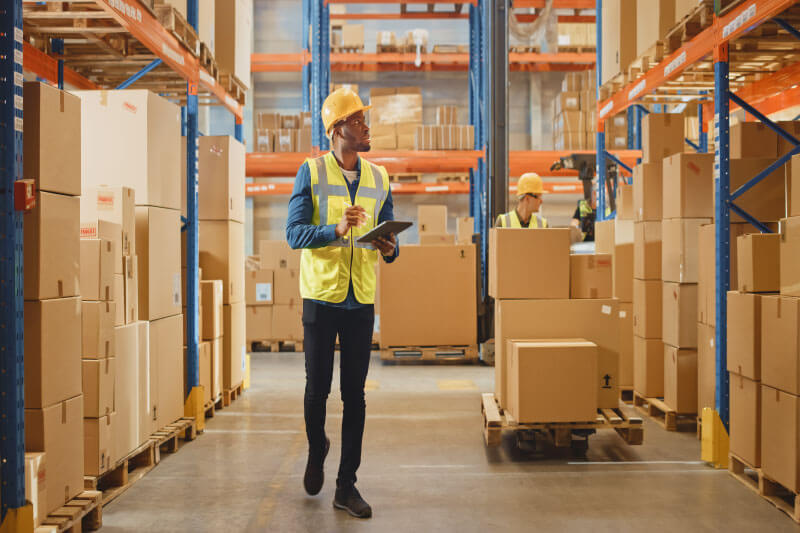Contents
Industrial IoT Solutions and IoT Systems Bring Businesses into the Future
While competing companies may have already harnessed the power of contemporary tools in the realm of smart manufacturing systems, including barcode systems, sensors, production data collection, and analytics software, there remains a wealth of untapped potential in this field. Emerging technologies now enable enterprises to amass vast amounts of data from consumer devices, their own equipment, and production lines.
The Internet of Things (IoT) has demonstrated the ability to completely revolutionize industrial production lines, enhancing flexibility, speed, and cost efficiency. At the heart of this transformative journey lies Litum IoT, equipped with highly trained specialists in the domains of RFID and RTLS systems. These experts are poised to elevate your business, factories, and production lines, unlocking the full spectrum of opportunities presented by the IoT landscape.
What is Internet of Things?
There are so many devices that have the ability to share data with you or a company these days. Modern technology has allowed people to connect our material things with the virtual environment of the Internet. Essentially, the IoT refers to the process of collecting information from these millions or billions of Internet-connected devices and sensors all over the world.
For instance, lots of people use an activity tracker, usually in the form of a wristband or ring, to monitor important health data. These trackers can monitor how many steps you take, your heart rate, and even how long and restfully you sleep at night. All of this data is sent wirelessly to the servers of the company that sells the trackers and is stored on their cloud.
Users can access their data via a phone app or computer to learn more about their habits, their overall health, and even how much progress is made towards a fitness goal. It is even possible to use multiple devices and sync them to an online account so that all health information is easy to track.
In this case, the activity tracker is a part of the IoT along with your cell phone and computer. They all connect automatically to the web to upload data, and in some cases, sync to share data automatically too.
The IoT allows everyone, including businesses, to get a better understanding of their productivity levels, where time is spent, locations that use their resources most frequently, and other essential data that can help with preventing unexpected health problems, or in the case of equipment, breakdowns, and repairs.
Types of Internet of Things
Since IoT is still in its very infancy, companies are just visualizing how it can be used to improve business and day-to-day life for consumers. Some uses have already been identified, such as health tracking devices and apps, while other ideas are still in the early stages of discussion. You could break the IoT down into several basic areas by how Internet-connected devices and sensors are utilized:
IoT in the Home
There may be up to a dozen or more wireless devices all participating in the IoT around your home, in your vehicles, and at work. This seems excessive until you start adding up the different devices used, such as A/C systems, lights, drapes, a wireless sound system, smart thermostats, and home security systems. Soon, we may all be living in ‘Smart Homes’ embedded with all manner of Internet-capable devices and sensors.
IoT in Industry
Businesses are champing at the bit to incorporate the IoT into production lines and offices. The small, inexpensive, and easy to produce passive RFID tag has allowed many to keep better track of inventory, distribution, and manage logistics. These tags are easily printed & encoded at the warehouse or production facility and affixed to packaging to travel with the product wherever it is shipped. The tag contains all of the necessary information about each product, which is quickly accessed and updated when scanned at each facility.
Small sensor devices, usually in the form of an active RFID tag, are also attached to mobile equipment, heavy machinery, tools, and vehicles to monitor location (RTLS systems), temperature, status, and even track regular maintenance and inspections. These devices are typically paired with software that stores this data for later reference or report creation.
Active RFID devices can even send alerts to designated personnel when equipment overheats, breaks down, or the operator uses it in an unsafe manner. With the industrial IoT, it is possible to extract data from transport and shipping vehicles, ambulances, ships, and planes, while they are literally on the go.
IoT in a City
Creating smart cities could be a potential end result of using the IoT to monitor and improve traffic flow, infrastructure, and power usage. At present, many employees are required just to gather data and check important systems throughout a city, such as traffic lights or roadways. Embedding sensors and wireless devices in these infrastructures could help streamline the monitoring and maintenance process that takes up so much time.

Managing Resources Better with Location Intelligence Provided By the IoT System
The growing technology of location intelligence is helping companies to better manage their resources and assets when used in conjunction with RTLS and RFID systems. If this is a lot to take in, try thinking of location intelligence as the software side of things and active RFID tags & readers, as the hardware.
It’s possible for manufacturing companies to use location intelligence systems and software to manage a wide range of resources and assets by tracking the movement of operators, products, equipment, and even pre-planning steps to take in maintenance.
There are other ways that businesses make use of location intelligence to reduce costs and improve productivity. For instance, the operations manager of a distribution company can use this software to track where vendor orders come in from and identify the fastest potential delivery routes that their trucks can follow.
RTLS even allows production managers to keep an eye on real-time customer demand and just-in-deliveries in process, so they can be alerted if there are delays or need to rush for any deliveries in order to keep up with the clients’ manufacturing.
Litum’s skilled specialists will help companies tie their existing RFID systems together with new, cutting-edge location intelligence systems (RTLS) that does so much more.
The Concept of Industry 4.0
What does this all mean for the industry? Well, the IoT plays a key role in the concept of Industry 4.0, otherwise known as, the fourth industrial revolution. The next wave of change in the manufacturing world will arise from the interconnectivity of machinery within each factory. Equipment and products communicate and interact with one another just like people would on a social network, except the goal of the factory is creating a finished product.
The Smart Factory is a natural result of Industry 4.0. This newly developed production space is very similar to the existing standard with multiple pieces of equipment that products move along in a linear fashion until they are completed, packaged, and shipped out. However, there are a few major differences.
Today’s manufacturing plant is usually directed by a central control unit or master control with all of the instructions for the manufacturing process that tells which machines to do what work. Work is efficient, but everything is guided by a single source.
A smart factory is decentralized with the instructions for completion of a product already added to the initial product part or else, its packaging, such as a shampoo bottle. This information is contained within an RFID tag that is easily scanned by each piece of equipment on the production line. Also, each of the production stations has a small processor that allows it to understand the instructions and determine what to do next.
A factory that fills shampoo bottles would have a production line with a fill station, and then a capping station, and a labeling station, and so on. Each station would scan the RFID tag to know what the product was and what to do with it before sending it on its way.
What Does This Mean for the Future?
Smart factories could allow companies to keep up with the ever-increasing demand for small batches of quickly manufactured products. Since everything is decentralized, each workstation can automatically send the product onto the next station as directed in the RFID instructions, rather than relying on a master control for input. The system would also be able to adjust automatically to meet the assembly requirements of each product that came down the line.
Rather than having multiple product lines for different bath products, you could have one product line capable of assembling different products as orders come in. The fill station may have tanks of liquid soap, shampoo, and cologne that it can fill three different bottles with as they come down the line before sending them onto a capping station with multiple lids and nozzles to use for sealing the bottle, depending on the product.
Different machines on the production line could also share information about breakdowns and delays to keep the entire system from clogging up. Stations can also communicate with managers and production floor staff, such as letting them know when the labeling machine needs refilling or when each order is finished and ready to move to the warehouse.
Litum Industrial Internet of Things Systems Transition Businesses into Industry 4.0
With our comprehensive selection of RTLS and RFID systems, Litum IoT can bring today’s companies into the industry of tomorrow. Ultra-modern smart factories and buildings are already being explored and developed by competitive companies that want to be at the forefront of this next industrial revolution.
If you have reached the maximum efficiency of current manufacturing technologies and distribution systems, it may be time to take your company in another direction.
Litum’s software experts and experienced RFID engineers work closely with companies to develop a streamlined production and distribution process that utilizes RTLS, RFID technology, location intelligence, and the IoT to work faster, cheaper, and with less downtime.
To find out more about how Litum IoT can help improve your operations, contact us now.






